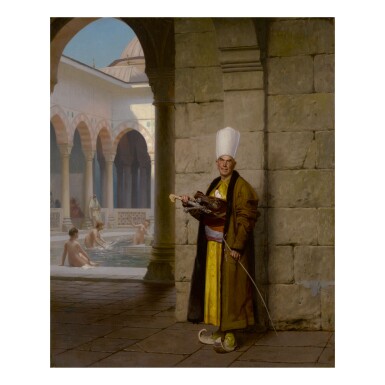
Property from a Private Southwestern Collection
JEAN-LÉON GÉRÔME | THE GRAND WHITE EUNUCH
Auction Closed
January 31, 04:23 PM GMT
Estimate
120,000 - 180,000 USD
Lot Details
Description
Property from a Private Southwestern Collection
JEAN-LÉON GÉRÔME
French
1824 - 1904
THE GRAND WHITE EUNUCH
signed J. L. GEROME. (lower right)
oil on canvas
24¾ by 19¾ in.
62.9 by 50.2 cm
Possibly, Goupil & Cie., Paris, no. 14903 (acquired directly from the artist, November 1880, as Eunuque)
Possibly, Sloane (acquired from the above, November 1880)
Goupil & Cie., London, no. 16455 (acquired January 1883, as Eunuque)
Reverend J.J. Couzens, London (acquired from the above, June 1883)
Ogden Goelet, New York
John Levy Galleries, New York
Hubert K. Dalton, Rumson, New Jersey (and sold, Parke-Bernet Galleries, New York, October 16, 1941, lot 80, as Harem Interior)
Louis Kaplan, New York (acquired at the above sale and sold, Parke-Bernet Galleries, New York, September 21, 1963, lot 33, illustrated, as Harem Interior)
Edward Binney III, San Diego (acquired at the above sale)
Sale: Christie's, New York, May 23, 1991, lot 44, illustrated
Acquired at the above sale
Possibly, Paris, Les Mirlitons (Le Circle de l’Union Artistique), 1884
Oeuvres de J-L Gérôme (Bibliotheque nationale), Paris, vol. XX, no. 1
Edward Strahan, ed., Gérome: A Collection of the Works of J.L. Gérome in One Hundred Photogravures, New York, 1881, n.p., illustrated
Fanny Field Hering, The Life and Work of Jean Léon Gérôme, New York, 1892, p. 161, illustrated p. 121
Frédéric Masson, "J.-L. Gerome: peintre de l’Orient," Le Figaro Illustré, Paris, July 1901, vol. XII, p. 10, illustrated
Possibly, Gerstle Mack, Toulouse-Lautrec, New York, [1938], reprint edition, Lexington, Massachusetts, 2019, n.p.
Gerald M. Ackerman, The Life and Work of Jean-Léon Gérôme, Paris, 1986, p. 252, no. 319, illustrated p. 253 (dated 1883)
Semra Germaner and Zeynep Inankur, Orientalism and Turkey, Istanbul, 1989, p. 119
Gerald M. Ackerman, Jean-Léon Gérôme, monographie révisée, catalogue raisonné mis à jour, Paris, 2000, p. 308, no. 319, illustrated p. 309 (dated 1880)
In 1870, while seeking refuge in London from the Franco-Prussian War, the celebrated French artist Jean-Léon Gérôme began a series of detailed pictures depicting the hammam, or Eastern bath. Though largely inspired by contemporary fantasies and misconceptions, and the artist’s own active imagination, many of these images contained important historical and cultural references that set them apart from those of his peers. In the present work, painted some ten years after Gérôme’s return to Paris, the figure of the white eunuch and his placement within the composition add a pointed political gloss to the scene, and set an intriguing narrative into motion.
Clad in brown and saffron-colored robes and set against a roughhewn stone wall, the "grand" eunuch of the picture’s title gazes outward at the viewer with cool aplomb. In the distance on the left, three harem women splash and play in the refreshing waters of an indoor pool, while their female attendants hover nearby. This vignette is reminiscent of several of Gérôme’s best-known hammam paintings, several of which were inspired by the architecture of the Topkapi Palace in Istanbul, which the artist would have known both from first-hand observation and from photographs purchased from the famous Abdullah Frères studio. (The women themselves were likely drawn from models in his Parisian studio, however, their lithesome postures referencing Gérôme’s lifelong interest in the contortions of the human body. Reliefs from Goujon’s sixteenth-century Fountain of the Innocents in Paris may also have provided a source of art historical inspiration here.)
The fair skin of the eunuch who stands at the portal leading to this scene is noteworthy, both within the context of Gérôme’s oeuvre and Ottoman history. Whereas white eunuchs, or kapı ağası, had enjoyed tremendous power and privilege under the early Ottoman caliphate, the reign of Murad III (r. 1574-1595) ushered in dramatic changes to the palace infrastructure. Black eunuchs (kizlar ağası) were introduced in record number as prisoners of war or gifts from various governors and almost instantly achieved a status equal to that of a grand vizier, facilitating communications within and outside of the palace walls, overseeing all royal ceremonial events, and, most importantly, protecting and administering the women of the harem— a duty that Gérôme depicted with some regularity and always to great dramatic effect (fig. 1). Their white counterparts, whose origins lie with the Christian populations of the Balkans or the Caucasus, were now relegated to the Selamlik, and the supervision of male pages, for reasons that remain unclear.
The presence and position of the eunuch in Gérôme’s picture takes on added meaning in this light. Is he an antiquated reminder of a palace society long since passed, a suddenly ostracized member of the Sultan’s reformed court, or part of a sarcastic commentary on the impotence of any guard to deflect the modern Western viewer’s gaze into the harem he was meant to protect?
This work will be included in the revision of Gerald Ackerman’s Jean-Léon Gérôme catalogue raisonné now in preparation by Emily M. Weeks, Ph.D., who also wrote this catalogue note.
